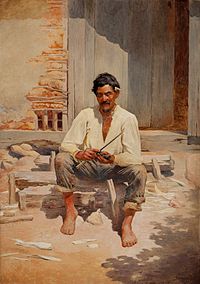| This is not a Wikipedia article: It is an individual user's work-in-progress page, and may be incomplete and/or unreliable. For guidance on developing this draft, see Wikipedia:So you made a userspace draft. Find sources: Google (books · news · scholar · free images · WP refs) · FENS · JSTOR · TWL |
| It has been suggested that this page be merged into Caipira. (Discuss) Proposed since March 2024. |
The tupi word caipira means "jungle ripper", a name given by Amerindians to white and caboclo men in São Paulo, Brazil. It entered the Portuguese language and became a generic designation for inhabitants of the countryside of the state.
Among its cognates are capiau (from the same tupi root, used in Minas Gerais) and matuto (from mato, Portuguese for jungle, used in the Northeast).
Since caipira presence has been gradually fading over the 20th century,

Origins
editCaipira people and culture have their origins at the region comprising the cities of Campinas, Piracicaba, Botucatu and Sorocaba, at the mid Tietê and also at the Paraíba Valley. All these places have historically developed as rural areas with links to the city of São Paulo and the port of Santos.
Due to recent industrialisation and migration, cities in these regions are gradually losing their caipira features. In some places, though, their characteristic accent remains, despite all changes (Piracicaba, for example).
Culture
editRather isolated in the countryside, they developed a peculiar and very localised culture, which preserved features of paulista culture from the colonial era.
Caipira culture is marked by strong Catholic religiosity, but also by its own superstitions, with a rich and diverse folklore.
Música caipira (caipira music), also called música de raiz, is typically about rural life, with romantic lyrics and melancholic singing, but with lively dancing.
Another typical feature of caipira culture is the telling of causos (orally preserved stories, often filled with mythical beings).
Dialect
editA distinguishing feature of caipira people is their way of speaking.
Considered by some as distinct dialect, this typical way of speaking is usually regarded as no more than a local accent as, though it sounds different, it is mostly understandable for people from other places of the country. It preserves some archaic expressions which can be difficult to understand, though.
In Brazilian culture
editMonteiro Lobato, influential valeparaibano writer born in the Paraíba Valley, eternalised a depiction of the caipira as a caboclo, portrayed by one of his characters, Jeca-Tatu.
Actor and film maker Amácio Mazzaropi, also born in the Paraíba Valley, made several successful films during the 1950s with himself in the role his own "Jeca".
Cartoonist Maurício de Sousa also created a caipira character, Chuck Billy (Chico Bento), for his comics series Monica's Gang (Turma da Mônica). Chuck Billy usually appears in short stories dealing with confrontations between rural traditions and urbanisation.
19th century Brazilian painter Almeida Júnior portrayed the typical caipira character and ambience in his works "Caipira picando fumo" (Caipira chopping tobacco) and "Violeiro" (Guitar player).
Sources
edit- CÂNDIDO, Antônio - Os parceiros do Rio Bonito , Sp, José Olympio, 1957.
- MONTEIRO LOBATO, José Bento de, Urupês, Editora Monteiro Lobato e Cia., 1923.
- NEPOMUCENO, Rosa, Música Caipira, da roça ao rodeio, Editora 34, 1999.
- QUEIROZ, Caipiras Negros no Vale do Ribeira editora da USP, 1983.
- PIRES, Cornélio - Conversas ao pé do fogo - IMESP, edição fac-similar, 1984.
- RODRIGUES, Ada Natal, O Dialeto Caipira na Região de Piracicaba , Editora Ática, 1974.
